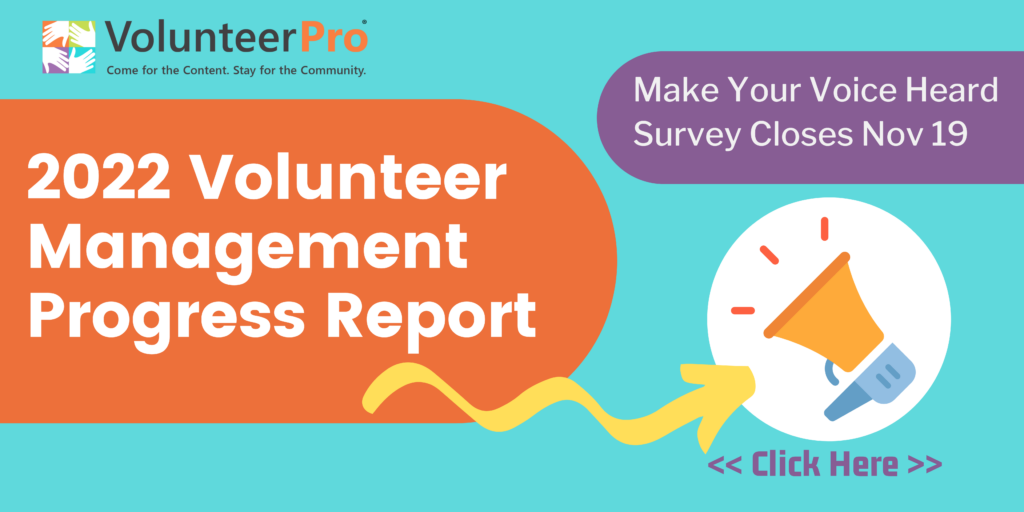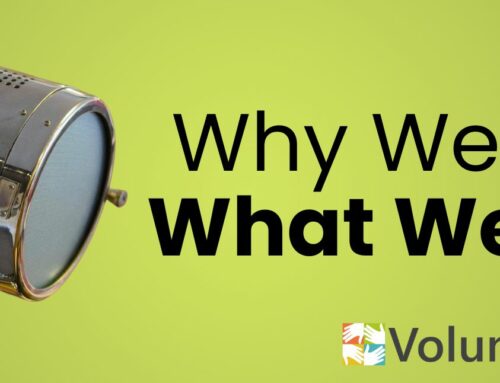November Pro Roundup: Resources to Improve Your Volunteer Program Design
When it comes to making tough decisions about your volunteer program design, it helps to know what other organizations are doing.
It also helps to set concrete indicators that will help you assess if your management interventions made a difference.
In this roundup, we share twenty-five of our favorite resources to help save time on your research. They cover the bases from national trends to sample outcome indicators. We hope these help inform the evolution of your practice and help you build buy-in for change and progress forward.
And, for a little fun, help you dream about a better future!
Trends in Volunteerism
If you want to make improvements to your volunteer program design, consider what’s impacting nonprofits and volunteerism all over the world.
When you understand these trends, you’ll be able to make informed choices that will be respected by your organization’s leadership team.
Here are some of our favorite resources that will keep you up-to-date on what’s happening in the field of volunteer administration.
United Nations, State of the World’s Volunteerism Report: The thread that binds – volunteerism and community resilience
In this report, you’ll learn how governments and local organizations can engage with volunteerism to encourage healthier communities and support the United Nation’s Sustainable Development Goals.
An estimated 1 billion volunteers are giving their time to make a difference on the issues that affect them and their communities. It’s certainly time we consider how volunteerism connects people, enabling them to work together to tackle the pressing issues of our time and make a difference in each community.
IAVE, National Leadership for Volunteering: A Global Perspective
In November 2016, volunteer administrative leaders from 38 countries gathered to share with, learn from and support one another. This is the report on their discussions.
This report provides insight on how to design and sustain a high-value volunteer program at your organization. One that encourages participation by breaking down barriers to participate, AND shows how volunteers are fundamental building blocks to society.
Check out the full report here.
VolunteerPro, The Volunteer Management Progress Report
Today’s challenges call on us to be more courageous than ever. They also call on us to be vulnerable, even when we don’t feel particularly strong.
Each year, as we develop the VMPR survey, we take a leap of faith. A leap that our distribution partners will help us spread the word and a leap that leaders of volunteers will answer the call.
The research topics also reflect our own values and priorities as professionals in this field and what we feel is most pressing to track over time. For example, promoting inclusive volunteering and equity is something we both care deeply about. So, we offer some data that might illuminate this area and give us pause.
We also know that this survey does not and will not represent all there is to know. It is snapshot in time, aimed at helping you make informed decisions.
Grab our 2021 report here and access the link to participate in our 2022 survey.
National Metrics
When you have the right data, you’re better able to back up your request for support.
But, if you don’t know where to find that data, you won’t be able to prove volunteer impact, and make suggestions to leadership for your organization’s volunteer program design.
Here are some resources to help you make the case.
NCVO, Getting Involved: How People Make a Difference
When people in communities participate, whether it’s through cultural, sporting, or civil life, it helps promote growth and enriches lives.
This report shows the trends of how people participate across Britain, and how that participation has changed over time.
In addition to detailing the good, the report also shows where improvements can be made. Namely in the areas of diversity and in utilizing emerging technology.
Independent Sector: 2021 Value of Volunteer Time
Updated in April, the current estimated dollar value of each volunteer hour is $28.54 (US $).
When you consider how volunteer contribute to every foundation of US society, it seems that they contribute much more and that in some ways their service is invaluable.
If you are curious why it’s important to put a dollar value on volunteer time, consider this:
Call Out: “The estimate helps acknowledge the millions of individuals who dedicate their time, talents, and energy to making a difference. Charitable organizations frequently use this estimate to quantify the enormous value volunteers provide.” – Independent Sector
Learn more here and consider calculating the value of volunteer time at your organization.
The Community Life Survey
The Community Life Survey is a national, annual survey of adults (ages 16+) in England that aims to track the latest trends and developments across areas that are key to encouraging social action and empowering communities.
This report measures more than just civic participation, too.
In it you’ll find data on how often people gather, how often they feel lonely, measures of life satisfaction, to rating their neighbor’s likelihood of coming together to help each other out.
All of this is measured to determine what factors might play into how willing people of a community are to get involved in formal volunteering.
Download the full report here and consider how you might be able to collect some of the same data in your community.
US Bureau of Labor Statistics, American Time Use Survey
The American Time Use Survey (ATUS) provides national estimates of how, where, and with whom Americans spend their time. It’s also the only survey that provides data on a full range of activities, including how many people are volunteering.
This research can be used to study how and why people do, or don’t, volunteer in their communities.
For example, if the research shows that families are having a hard time balancing careers and family responsibilities, then there is likely going to be less civic participation from those raising young children.
Learn more with the full report here, while keeping in mind that the data is not truly representative of a “normal” year due to the pandemic.
Volunteer Program Standards & Core Competencies
Your approach to managing volunteers can have a direct impact on whether or not they are successful.
If you choose volunteer involvement as a model to meet your agency’s needs, then it is your responsibility to design an environment where the community can have a pivotal role in your success through meaningful service.
And, with the myriad of tasks associated with volunteer management, ensuring you cultivate the right foundational volunteer coordinator skills can be quite the challenge.
Here are some resources that can help you hone the right volunteer management skills to ensure success.
“Body of Knowledge in Volunteer Administration,” Council for Certification in Volunteer Administration
The CVA Competency Framework clarifies and defines the full range of tasks involved in the professional management and leadership of volunteer engagement.
There are seven key competency areas:
- Plan for Strategic Volunteer Engagement
- Advocate for Volunteer Involvement
- Attract and Onboard a Volunteer Workforce
- Prepare Volunteers for their Roles
- Document Volunteer Involvement
- Manage Volunteer Performance and Impact
- Acknowledge, Celebrate and Sustain Volunteer Involvement
Learn more about each competency, and get a list of specific tasks that fall under each area by downloading their framework.
Making the Case for More Funding
It’s no secret that volunteer services departments suffer from an often-stunning lack of adequate resources.
So, the perennial question — how do we get more money?
One way to encourage deeper support is to routinely and concretely show how the resources were used effectively today and to make a case for how they can optimize operations tomorrow.
Use these two resources to learn just how to do that!
The Leighty Foundation, Guide for Nonprofits (to get funding for volunteer engagement)
If funders are having a difficult time recognizing how volunteer engagement fulfills your organization’s mission, it’s time for you to consider how you can make the case for how volunteers lead to mission impact.
When you do so, you’ll learn how you can inform organizational leaders and potential funders on how volunteers support the capacity of your organization.
Volunteering Australia, The Value of Volunteering Support Services
The Value of Volunteering Support Services report provides a socio-economic analysis and evaluation of the value of Commonwealth funded Volunteering Support Services.
Volunteering provides critical infrastructure support to communities, and Volunteering Australia recognizes that support in this report.
Their research shows how many hours are given, and the economic value that is generated from volunteer involvement.
Sample Outcome Indicators & Reporting Dashboards
When you think of what your agency’s volunteers achieve, have you decided how you will measure volunteer impact?
You’re probably already tracking volunteer hours, and perhaps using the Independent Sector’s Value of Volunteer Time to calculate the equivalent in wages that volunteers contribute. This is certainly a start, but this data doesn’t offer a complete picture.
Incomplete data may set you up for future headaches. So, beyond the value of volunteer time, consider developing a set of metrics that describe the impact your volunteers will achieve.
Check out some of these resources to help you determine where you should focus your energy!
Urban Institute Outcome Indicators Project
The Outcome Indicators Project offers frameworks for tracking nonprofit performance across a wide range of organizational impact areas. They also include logic models that describe theories of change for each set.
If you are wondering what to measure, how to do it, and how to report on it, then it will benefit you to take some time to build a common framework for outcomes.
Learn more about the project here.
CompassPoint, Library of Sample Dashboard Indicators
If you are still unsure of which outcome indicators are important to measure, this resource also shows the types of indicators other organization have used, broken down into 10 categories.
While volunteer management is one of the categories, if you place volunteers in other programs at your organization, they can have an impact on any of the indicators in this list!
Take a look and see what indicators will be relevant for you to start tracking. Just a note, to not try and do it all! Your indicators will depend on your organization type, your strategic plan, and your unique leadership.
Self-Assessment & Team Culture Tools for Volunteer Program Development
When you take some time to self-assess your management skills AND your volunteer program to see how they stack up to other programs, you’re better able to design a volunteer program strategy that gets more traction.
If you’re not sure where to start your assessment, check out some of these tools.
Social Impact Architects, Impact Culture Checklist
The calling to be a volunteer manager is quite abstract. This is mostly because Volunteer Management isn’t recognized as a professional career path, leaders of volunteers usually don’t control their own budget dollars, and the position is often seen as entry-level.
The calling of a volunteer manager is also a mighty task. This is mostly because leaders of volunteers are pretty much a secret pillar. The wave their seemingly magic wands, mobilize the power of volunteers, and invisibly steer nonprofits to success.
This means, volunteer managers also have a direct impact on their organization’s culture. And, when you create an impact culture, your colleagues and volunteers will be motivated to learn, take action, and embrace change.
Grab the checklist here and assess your volunteer program to see how many boxes you check off and get your Impact Culture score!
Greater Good Center, Grateful Organizations Quiz
Have you ever been the lucky beneficiary of expressions of gratitude from clients and friends. Their heartfelt thank you notes really lift spirits during tough weeks.
Have you ever stopped to think about the power of gratitude? How might it be harnessed as a strategy to support the emotional health of volunteer teams?
At times, leaders of volunteers, like other leaders under stress, feel isolated and unappreciated. We look outside ourselves for validation of our work, and if it isn’t there, we become frustrated.
What if we took direct responsibility for changing the mood and culture of our organizations by becoming more grateful? What if we led with gratitude? Would it make a difference in the effectiveness of our volunteer teams? Of our organizations as a whole?
And, if so, how would we get started?
Research has shown that, indeed, gratitude can have a powerful effect on people. It seems particularly suited to volunteerism – a field that is driven by compassion.
Take the Grateful Organization’s Quiz to learn your organization’s gratitude score, and ideas for cultivating more gratitude at your organization.
Harvard University, Project Implicit
Wondering about hidden biases that may impact whether volunteers feel included? The Implicit Association Test (IAT) can help. It measures attitudes and beliefs that people may be unwilling or unable to recognize in their work (and personal) behaviors.
When you work with volunteers and diverse populations, it’s important that you are aware of any implicit attitudes in yourself and others you may not be aware of.
For example, you may believe it’s important that women and men are given the same volunteer opportunities, yet you might automatically associate administrative volunteer roles with women and hands-on, heavy work volunteer roles with men.
By taking an IAT, you’ll learn more about your own implicit attitudes and how they might be affecting your ability to recruit and retain committed volunteers.
Your Volunteer Program Design Next Steps
Now that you know about the various outcomes your volunteers can have, it’s time to start designing a program that generates max results.
What will you start tracking first? Let us know in the comments!
Leaders like you have exhibited phenomenal spirit and dedication in 2021. And we want to ensure that your voices and experiences are heard.
In this survey we will explore the impacts of COVID on both you and your organization over the past year. We appreciation your participation.
Your answers will be anonymous and the survey takes LESS THAN 5 MINUTES to complete. At the end of the survey, you will be able to register for a free Sneak Peek Webinar where we will share the early results exclusively with participants before the general public.









